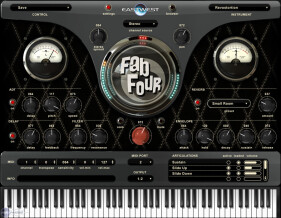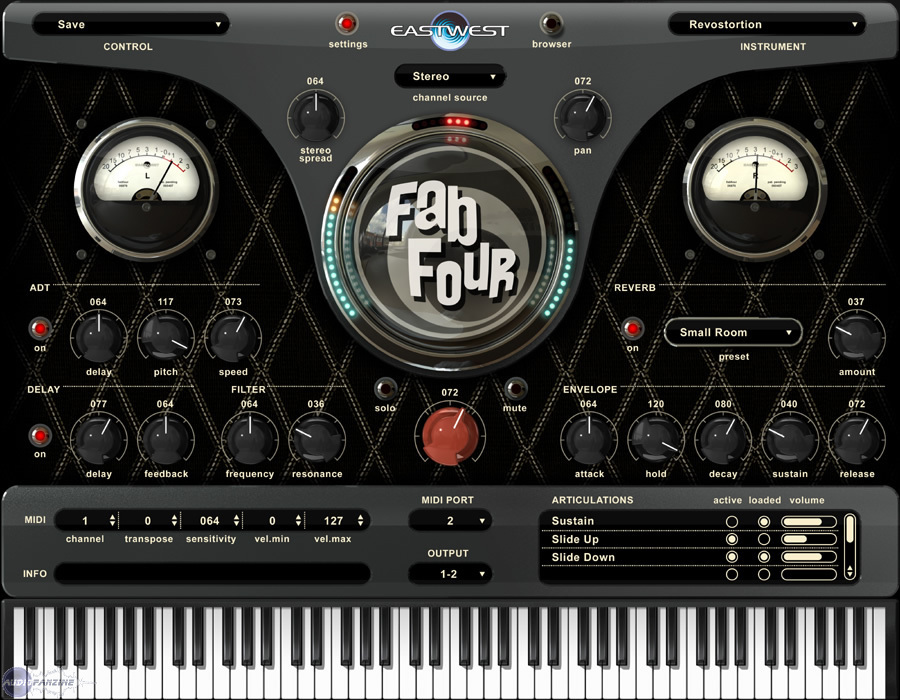After 20 years of editing hi-quality sample libraries, EastWest has taken the plunge and released its own sample player, simply named Play. At the Winter NAMM 2008 the editor unveiled several products which will be using this new instrument. Let’s start by reviewing three that are already available, Fab Four (FF), Gypsy and Voices Of Passion (VOP).
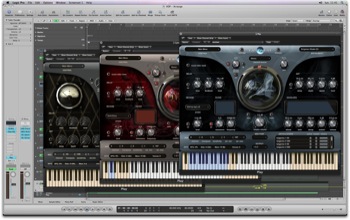 |
In the world of sound libraries, quantity and quality have quickly led from floppy disk storage to DVD’s. There’s such a race for GBs that some libraries are now sold already installed on hard disks…
It also means that the end user as well as the editor are now facing two imperatives: the RAM/streaming handling and the mass of existing sampling formats, practically equal to the different number of existing samplers whether hardware or software. Fortunately, some format converters allow you to import samples and programs from various sources into your favorite sampler, even if you sometimes lose programming subtleties specific to certain formats.
In order to offer autonomous solutions, some editors have chosen to use a player under license (EastWest, Zero-G, Best Service with N.I.’s Kompakt, Spectrasonics, Motu with UVI, etc.). Most of them have now designed their own player, firstly to avoid unpredictable compatibility issues, secondly to benefit from financial and technological freedom.
The reading issues are very different. Either you choose to read from the hard disk (streaming), necessitating a fast reading protocol and ideally dedicated ports and disks, or you choose to read samples from RAM, then you are confronted to the 32-bit OS limit, that is to say 4 GB maximum (2 to the power of 32). Certain programs allow to you use a combination of both solutions. However, if you’d like to exceed the current limit, you need to use 64-bit calculation (2 to the power of 64, theoretically 17 billion GB…).
EastWest has released its own solution, Play, a 64-bit (32-bit compatible) sample player.
Play
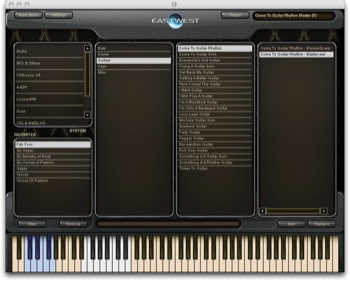 |
Mac (UB) and Windows (XP and Vista) compatible, Play is available as a standalone and a plugin in AU, VST, RTAS, the latter Mac only (PC to come) and needs an iLok protection key.
The concept: a player whose graphic interface and parameters change according to the loaded instrument or library. Play can only use specifically designed libraries (no import or reading of other formats), whose instruments are made up of samples with different velocity layers and articulations, the latter being selected by keyswitches. There are two kinds of presets: Elements, which have only one active articulation and Masters which use all. Play is multitimbral and multi-channel. The upper part of the interface groups together pull-down selection, Control and Instrument menus. The EW logo is flanked by two buttons: Settings (audio, MIDI, streaming settings, etc.) and Browser. You’ll be able to recall the 10 most recent presets in Control.
Channel Source allows you to read various versions of a preset: stereo, mono (L/R sum) and mono from either Left or Right. You’ll find a Pan and a Stereo rotator, whose use varies according to the loaded library: in Fab Four for example, it lets you simulate a stereo signal from mono samples (you can hear two distinct samples, maybe in the same way that Virtual Guitarist works, reading and directly transposing samples that are one semitone away from the played note). In other libraries, it widens the stereo signal while delaying one of the audio channels of a stereo signal, such as recordings made with two different mics (voices in VOP). You should avoid tweaking this setting while playing in real time or by automation, because it produces audio artifacts.
Other functions
 |
Several display windows in the lower part indicate the streaming activity, the Midi parameters and the sound activation/selection. MIDI allows you to select channels, transposition (more or less two octaves), velocity response and its range. Info gives you information on CPU charge (not a reliable tool…), hard-disk activity, used RAM and voice number (which is different from note number).
In MIDI Port you can select which MIDI controller/keyboard will be active, but only in standalone mode. When Play is used as a plugin, this depends on the host’s preferences. Since this setting is on a by-preset basis, you can assign a specific MIDI controller per loaded instrument. Just below you’ll find access to the separate outputs: in standalone mode, you can route audio to the different outputs of your soundcard. In plugin mode, Play doesn’t yet offer separate outputs in Logic8 (but it does in Logic7), Cubase, Nuendo and Pro Tools and EW have stated that it will be available soon .
The last display is Articulations: from left to right you’ll see the name, the keyswitch used, whether a sound is active or not, whether it is loaded or not (you can unload sounds to free up some Ram), and an adjustable volume.
Then you have a keyboard displaying unused notes (in yellow), articulation range (in white) and keyswitches (in blue). This keyboard is fully functional and can be fun to play around with using a mouse (nice glissando…).
The central area includes a display window flanked by three vu-meters for L/R levels and Pan. The functions are the same for the three libraries, but will change for forthcoming ones (QL Pianos, Symphonic, Forbidden Planet, etc.).
The controls are practically the same, they’re just located at different places depending on which library is loaded. A delay with a Time setting (0.2 to 4.6s, with analog pitch emulation when you quickly move the parameter), Feedback and Level, then an AHDSR envelope (up to 10s for each segment, from 0 to –120 dB for sustain), Volume and its Mute and Solo (independent for each loaded instrument) and, with the exception of Fab Four, a low-pass resonant 12B/oct filter (cutoff from 35 to 23999 Hz). A Reset Round Robin knob which forces the plugin to start on the first sample when using presets with alternate samples.
Spaces and samples
 |
EastWest has designed an ADT (Automatic or Artificial Double Tracking), a system allowing you to artificially double a track, designed by Ken Townsend at Abbey Road. EW has done a great job on it: Delay, Depth, and Speed emulate the original while Level sets the relative level of the added signal. Only issue, Delay and Depth can’t be automated, Especially Depth, since it produces clicks when modified while you play.
However, you should be careful when you set ADT and Stereo, otherwise you may create serious stereo phase issues…
Finally, there’s an impulse reverb with 35 impulse responses including plates (EMT), Hall, Studio, Chamber, Church, etc. Seeing that the quality is very good, it would have been nice to have more than one and only one parameter (Level). But I imagine it would have resulted in a more demanding effect, while this is relatively light on the CPU.
It’s time for some details about the presets. EW has implemented keyswitches, allowing you to jump from an articulation to another by sending a MIDI note (in real time or via a sequence). An articulation is a sound variation, a playing technique, noises, etc. of the same instrument. Play recognizes when you are playing legato and immediately selects legato samples, but be careful, because the plug is not monophonic: if two notes overlap, they are both heard, because one does not cancel the other out. The suffix Mod refers to a sound modification that can be done via the Mod Wheel (adding distortion samples, switching between slow and fast strumming, level of release samples, etc.). When there’s a DXF in a preset name, it means that the Mod Wheel is used to fade between several layers. RR indicates Round Robin: different samples of the same note will be triggered each time this note is played repeatedly (which avoids the “machine-gun” effect).
On the down side, commands are fixed and there’s no MIDI learn. The only way to automate Play is to use the host’s automation and there’s only a few parameters available. But there are also parameters which aren’t on the plugin interface, such as different filter topologies. Another shortcoming is that the circular knobs are imprecise, making it difficult to get to the extreme settings. Fortunately, the mod wheel can be used as a modifier for all parameters and allows access to any value.
Fab four
With such a name, can there be any doubt? EW has enlisted Ken Scott (sound engineer on the White Album and Magical Mystery Tour), Laurence Juber (Wings) and Denny Seidwell (drummer on three McCartney records). In searching for authentic sounds, the editor has assembled almost all the instruments, amplifiers, mics and outboards used in that period on these wonderful records. Vintage noise and artifacts are guaranteed, but they’re perfectly controlled, never making an instrument unusable. Thus you’ll have, under your fingertips, the sound of a 63 Hofner and a 64 Rickenbacker bass, a superb Ludwig drum kit, a 56 Epiphone and Strat, a 57 Les Paul, a 51 Tele, Gretsch, Rickenbacker guitars, etc. And some very rare keyboards, such as a Clavioline (a Selmer model?), a Baldwin electric harpsichord or a Lowrey Heritage Deluxe organ. Some tablas, percussion, sitars and screaming girls(!) complete a rich « instrumentarium » (13 GB of samples).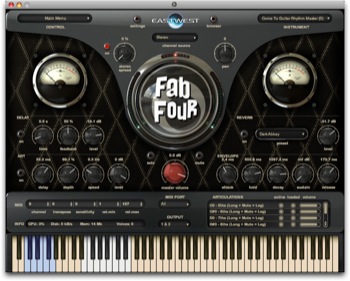 |
The question to be asked: is Fab Four only useful for Beatles covers or can it be used in other musical styles? The keyboards, guitars and basses can be used in pop-rock or acoustic oriented music without any problem. The round bass sounds will sit perfectly inside a mix, their various articulations allowing realistic programming. The keyboards are amazing, even if the Madonna Piano could have used more layers. Also the harmonium, which has a great sound, could have used looped samples, since some notes are really short (some re-sampling?). Other great instruments: the Within A Sitar and its six articulations, which works perfectly in videos or movies, or the percussion with a quite rare set of real handclaps.
As for guitars, EW has sampled the chords according to the harmonic progression of particular songs, and also each note of these guitars. The Chords will no doubt let you do perfect covers of the song they refer to, thanks to the exact strumming, up-down strokes, effects, etc. On the other hand, it will be a bit difficult to use them to build completely new songs.
As for the chromatically sampled guitars, the sounds are definitely dated, without a lot of “body”, but this is what makes them interesting. You can easily twist them to make nice backgrounds by tweaking the reverb, pan and delay. Or make any kind of part, since you once again have numerous articulations for each instrument (slide, hammer, pull-off, mute, etc.). And it’s true for electric as well as for acoustic guitars: (••001-bluebird.mp3••) can also do (••02-modern.mp3••). Or if you blend this guitar (••03-roll.mp3••) with the harmonics of this one (••04-withoutalittle.mp3••) and with this bass (••05-come.mp3••), you can get this (••06-surprises.mp3••).
Let’s talk about the drums. First comment: it’s great having right/left hand and alternate (Round Robin) samples. Sound-wise, EW has faithfully reproduced every typical sound of Starr’s drum sets: dull sounding toms (the “cardboard sound”…), heavily compressed cymbals, short snares but with a lot of wires, etc. Hi-hats have a really pleasant response when played on the keyboard. You won’t be able to use every sound in all contexts because they have been recorded and produced (reverb, compression…) to reproduce the original sounds, but there are some real goodies to use here and there in modern production. Too bad you’re not able to pick various sounds and gather them within personal presets.
Basically, Fab Four is a sound library that does exactly what it says, and that you can use in non-liverpudlian styles. However don’t buy it if you need a totally versatile instrument…
Gypsy
Now we’ll move on to Gypsy, another specialized instrument, maybe more versatile than the Fab Four. With such a name, acoustic guitars are clearly honored, but so are accordions, bandoneons, violins, various percussion, even a trombone and a cimbalom. Once more, the overall sound quality is top-notch and the numerous articulations make these instruments really enjoyable to play (12 GB of samples). |
Among the guitars, the Classical, Flamenco and Spanish Steel String are very detailed, offering between 4 and 16 articulations, from legato to taps on the guitar body, from harmonics to half or whole-tone slides, etc. Seeing that there are the three main kind of acoustic guitars, it was tempting to try this (••07-medgypsy.mp3••). The chords couldn’t always be used, since they’re tempo-dependent (strumming, rasgueado, etc.). Software such as Melodyne or Recycle could be useful in modifying and adapting the various rhythmic figures to a given tempo
.
Unfortunately, the Django guitar doesn‘t quite cut it: neither the solo guitar nor the chords are convincing, there’s no way to simulate decent gypsy comping. It’s a pity because you’ll be hard pressed to find Selmer/Maccaferi guitars in other libraries. There’s another problem: when you load any guitars, the violin or the trombone, the reverb level is at 0 dB, rendering the instrument virtually unplayable. So you’ll have to manually modify this setting and possibly save it as a new preset.
The Cimbalom is amazing, with rolls (only one tempo, alas), recorded in such a way that you can hear the sound of the beaters (mallets) as well as the wood resonance. A rare instrument, ideal for quickly creating movie ambiances. Almost every film composer has used this sound, in one way or another.
There’s not much to say about the trombone, which seemed quite ordinary, except to say that it has True Legato articulation.
The accordions and the bandoneon have that “acoustic” quality with their air and key noises, typical of this editor’s former productions. They are extremely expressive, thanks to numerous articulations, crescendo, sforzando and to the sampling of various settings (musette, single reed, double reed, etc.). Always reaching for authenticity, EW has sampled the airflow going in and out, as well as the player’s left and right hands. On the other hand, you have to get used to hearing the left hand in your right monitor and vice versa, as EW has chosen the “from the public” perspective. You can easily change this with an appropriate plugin. If you’re desperately looking for realistic though virtual “squeeze boxes”, ranging from the tension of Astor Piazzola to the lyricism of Richard Galliano, from the linear quality of Hermeto Pascoal to the swing of Gus Viseur, stop searching, you’ve found them…
We’ll end with another masterpiece, the violin. 26 different articulations make it one of the most detailed instruments of the series. Two Legato presets offer specific samples, with the Mod Wheel controlling the speed and length of the transition between notes. With some programming you can obtain stunning results with the original sound as well as with effects for some Ponty-Lockwood-like sounds, or like on this modest tribute (••08-itsbeen.mp3••).
To conclude, Gypsy is an exceptional plugin, which is perfect for when you need acoustic guitars, accordions, cimbalom or violin. However, I have two regrets: there’s no pitch bend for the violin! And sometimes the stereo image slightly differs from one articulation to another. Of course you can correct that with pan or some plugin, but it’s a bit annoying.
Voices of Passion
The last instrument in this review, Voices Of Passion, features the voices of five female singers from USA, Wales, Syria, India and Bulgaria (7.3 GB of sounds). Once more, the overall sound quality is second to none. The recordings have been made in stereo, with a Telefunken Ela-M 251 tube mic and a RCA 44 ribbon mic. You can choose either one, or use both without any phase issue. Samples are mainly vowel based, but you’ll find consonants, articulations, words and phrases. Almost all the presets use reverb, so no doubt some will prefer to lower or turn it off.Each “instrument”, America, Bulgaria, India, Syria and Wales, has Elements and Master programs, and three of them have more to offer: America has “Oo” in True Legato and Portamento and Bulgaria has Breath sounds. Wales is the most complete since in addition to “Ah” and “Oh” in True Legato, Portamento and DXF, East West has sampled vowels, words and phrases. Even if the recording is near perfect, playing solo, chromatically and/or legato sometimes results in slightly artificial sounds, because of some cancellation or addition of certain frequencies/harmonics.
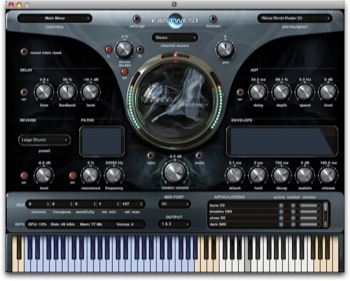 |
America Master offers 10 articulations, from “Ah” to “Muah”, in a Enya-esque or Dead Can Dance type moods. These sounds were clearly conceived, and are perfect, for pads or single notes, but not to build melodies.
Bulgaria is more specialized, offering pads as well as words or articulations, and typical phrases as sung by the Bulgarian Voices (••09-bulgarianmood.mp3••). The concept, also used in some other voices, is to offer complete phrases whose first note corresponds to the note played. Then the phrase development is more or less free. This way, you are always sure of playing a word or the first word of a phrase corresponding to the current tonality/chord.
India uses a slightly different concept: even if it also uses complete phrases, they are limited to some tonalities and lack the chromatic flexibility of Bulgaria. There’s a nice feature: the Mod Wheel changes the starting point of the phrase, so if you hit the same note twice, you’ll be able to have two different results.
This Mod Wheel function is also used in Syria, but this time the phrases are sung according to the note of the Keyswitch. If you hit the “F” Keyswitch, all the phrases of the articulation will be in F (major, minor and various modes).
As stated earlier, the most complete voice of VOP is Wales, which offers no fewer than 44 articulations plus 8 independent articulations (“Oh”, “Ah” in legato or DXF). This time the Keyswitches select syllables, vowels or chromatically mapped words, thus ensuring easy harmonization. No matter what the phrase means here, the vocal construction will rather sound like the work of Elizabeth Fraser but will sound different, since the vocal timbre is different.
All the voices of VOP show great consistency, and their timbral quality is quite regular. Only a few loudly sung phrases sound a bit “outside”, since vocalists had to move away from the mics when most of the library is close-miked. Even if all the phrases of an articulation are homogenous, it slightly differs from one articulation to another. So you’d be better off using VOP without the included reverb, selecting mono Channel Sources, or making various plugin and bus routing in order to smooth over some imperfections and to tighten small stereo variations between Keyswitches.
In any case, VOP is a superb instrument, much more practical to use than a loop library and it will do perfectly when you need to compose for movies, for example. Working with Melodyne, Time Machine, Radius or any similar soft/plug will increase VOP’s potential. The goal is to be free from tonality and rhythm constraints, with top-notch time stretch and pitch shift quality.
Some regrets: both Syria and India could have offered more sounds, at least as much as the others. Then there’s some strange noises here and there, like the C#4 of Bulgarian Master/articulations D0, or some notes of the same layer where you can hear that one of the mics distorts very slightly . And above all, I wonder why EW hasn’t implemented any kind of a Wordbuilder like the one the editor made for Symphonic Choirs?
Conclusion
EastWest has successfully broken into the virtual instrument developer world. Play has got the sound, is quite intuitive, has a really nice graphic design (even if a bit imposing) and above all comes as a 64-bit plugin with all the advantages of this format. The sound libraries themselves are of course worthy of this editor’s reputation, with its “big” acoustic sound.However, since nothing is perfect, there are some flaws and shortcomings: the CPU strain on “old” computers, some unconvincing instruments, some disparities between articulations of a preset, tiny noises on a few samples, the Stereo Double mode can be a source of imaging problems, the impossibility of gathering and saving samples from different programs in user’s presets, etc.
The assessment is, on the whole, positive. Foremost because the plugins live up to their names: each one does exactly what it was meant to. In my opinion, Gypsy is the best of the series, followed closely by VOP for its versatility, despite the lack of content for India and Syria. Fab Four is more anecdotal, even though it could be used in various modern productions. In regards to VOP, one might regret the absence of time stretch, pitch shifting abilities and an equivalent of Wordbuilder.
Of course, it’s up to each person to judge each Play instrument utility compared to its projects. But movie composers, and composers in general looking for great sounds with some unusual ones will find numerous possibilities, great ease of use and top-notch sound quality in these instruments.
[+] Excellent sound quality
[+] Only one instrument for all libraries
[+] Multitimbral
[+] bit plugin (Ram handling…)
[+] Uniqueness
[+] Proclaimed and successful specialization
[+] Really great instruments and voices in Gypsy and VOP
[+] Fab Four’s successful nostalgia
[+] Complete sounds
[+] Various articulations
[+] Keyswitch use
[+] ADT
[+] Mod Wheel implementation
[+] Simplified and streamlined settings
[-] Some failed instruments (Django…)
[-] Tiny noises on a few samples
[-] Some imaging issues (Stereo Double)
[-] Lack of precision in min and max settings (except when using Mod Wheel)
[-] Too much reverb on some presets
[-] No multi-outs when using Logic 8, Cubase, Nuendo and Pro Tools
[-] No copy-paste or import from one preset to another
[-] Some instability
[-] Unreliable CPU gauge
[-] Heavy on the CPU


